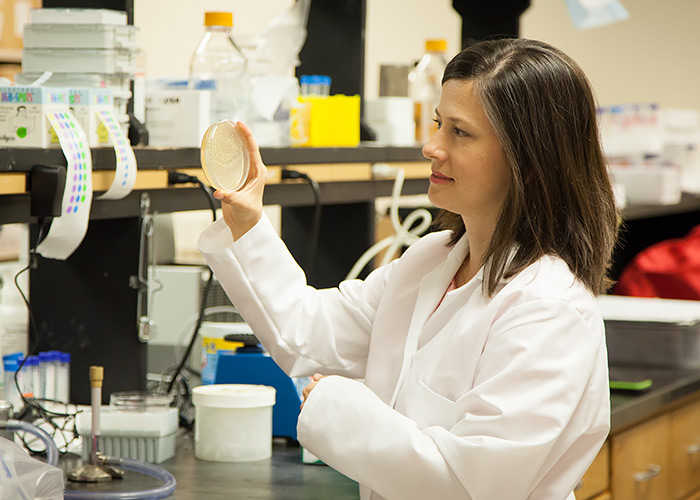$697K Grant for Studying Cheating Behaviors in the Amoeba Dictyostelium Discoideum
Everybody cheats. Even amoebae.
Elizabeth Ostrowski, assistant professor of biology and biochemistry at the University of Houston, was awarded a four-year, $696,634 grant from the National Science Foundation to study the evolution of cheating behaviors.
 Elizabeth Ostrowski, assistant professor of biology and biochemistry, studies the
evolution of social cooperation in Dictyostelium discoideum.She will conduct her research using the model organism Dictyostelium discoideum, Dicty for short, which is a soil amoeba. During times of famine, Dicty amoebae aggregate
into a multicellular organism capable of moving, developing and releasing spores.
Elizabeth Ostrowski, assistant professor of biology and biochemistry, studies the
evolution of social cooperation in Dictyostelium discoideum.She will conduct her research using the model organism Dictyostelium discoideum, Dicty for short, which is a soil amoeba. During times of famine, Dicty amoebae aggregate
into a multicellular organism capable of moving, developing and releasing spores.
“My research asks how organisms can work together as a community, even when only some individuals stand to benefit from this cooperation,” said Ostrowski, who joined the College of Natural Sciences and Mathematics as a faculty member in 2011.
When food gets scarce, Dicty cells start signaling to each other as part of a process in which they come together to give some individuals the opportunity to survive by moving to more favorable environments.
First, cells aggregate together to form a little worm-like creature called a slug, which can crawl around and is attracted to light and heat. From this slug stage, the cells will start taking on different roles in order to form a thin, upright stalk that supports a fruiting body that releases the spores.
Creating this stalk structure, which provides the necessary support for the fruiting body, means that some cells have to die. The remaining cells will get pushed up to the top of the stalk, forming spores.
 Dictyostelium discoideum is a soil amoeba that aggregates into an organism capable of moving, developing and
releasing spores during times of famine.“These stalk cells are behaving altruistically – they’re giving up their lives to
push up the remaining cells which then become spores capable of dispersing to more
favorable environments,” Ostrowski said.
Dictyostelium discoideum is a soil amoeba that aggregates into an organism capable of moving, developing and
releasing spores during times of famine.“These stalk cells are behaving altruistically – they’re giving up their lives to
push up the remaining cells which then become spores capable of dispersing to more
favorable environments,” Ostrowski said.
This tension between cells that are destined to die and cells that are destined to survive is a conflict that strikes at the heart of natural selection. The cells that form spores will go on to reproduce, passing their genes on to the next generation. The cells that form the stalk will die, their gene copies relegated to an evolutionary dead end.
“Because these cells are aggregating to become multicellular, this means you can have different strains within the same multicellular organism,” Ostrowski said. “This creates opportunities for selection to favor cells that behave selfishly by preferentially getting into the spores, rather than forming the stalk. It’s like cheating on your taxes – you get all the benefits without paying the costs.”
This potentially creates what is called an evolutionary arms race: different strains compete to preferentially form spores, rather than stalk cells. Some strains will cheat, forming more spores than stalk cells. Other strains will develop resistance to these cheaters, ensuring that the different strains contribute equally to stalk and spore formation.
“Evolutionary arms races are highly dynamic, as they force species to adapt to a moving target,” Ostrowski said. “These systems are really hard to study because you’re looking at a snapshot in evolutionary time – cheaters might be ahead in the moment you are looking at, only to be behind the evolutionary race in the next.”
While these arms races between cheaters and resisters have been studied in laboratory experiments, they have not been observed in nature.
“I want to understand what is happening out in the wild,” Ostrowski said. “To do that, we will be observing the trajectories of cheating and the potential for resistance in different populations.”
To understand the long-term dynamics of cheating and resistance, Ostrowski’s research team will collect samples from more than 100 locations throughout the eastern U.S.
“What you see at any moment may not reflect the long-term dynamics of a population,” Ostrowski said. “One way of addressing this is to look across many different populations, to get an overall picture from looking at many, many snapshots, each a different race.”
Using these samples, Ostrowski’s research team will look at the genetic makeup of these populations, so that they can understand the different ways Dicty adapts to the presence of cheaters.
- Rachel Fairbank, College of Natural Sciences and Mathematics